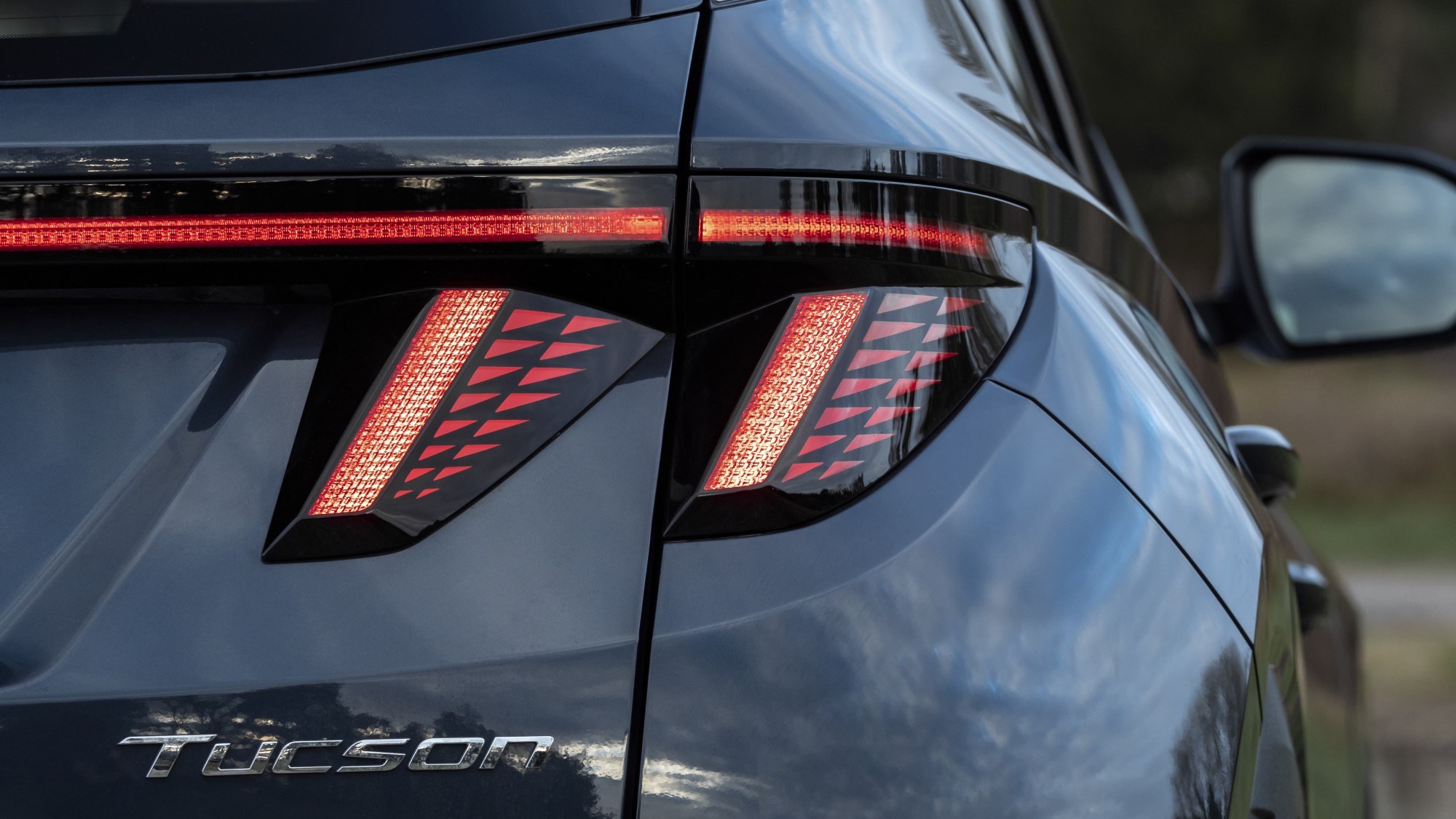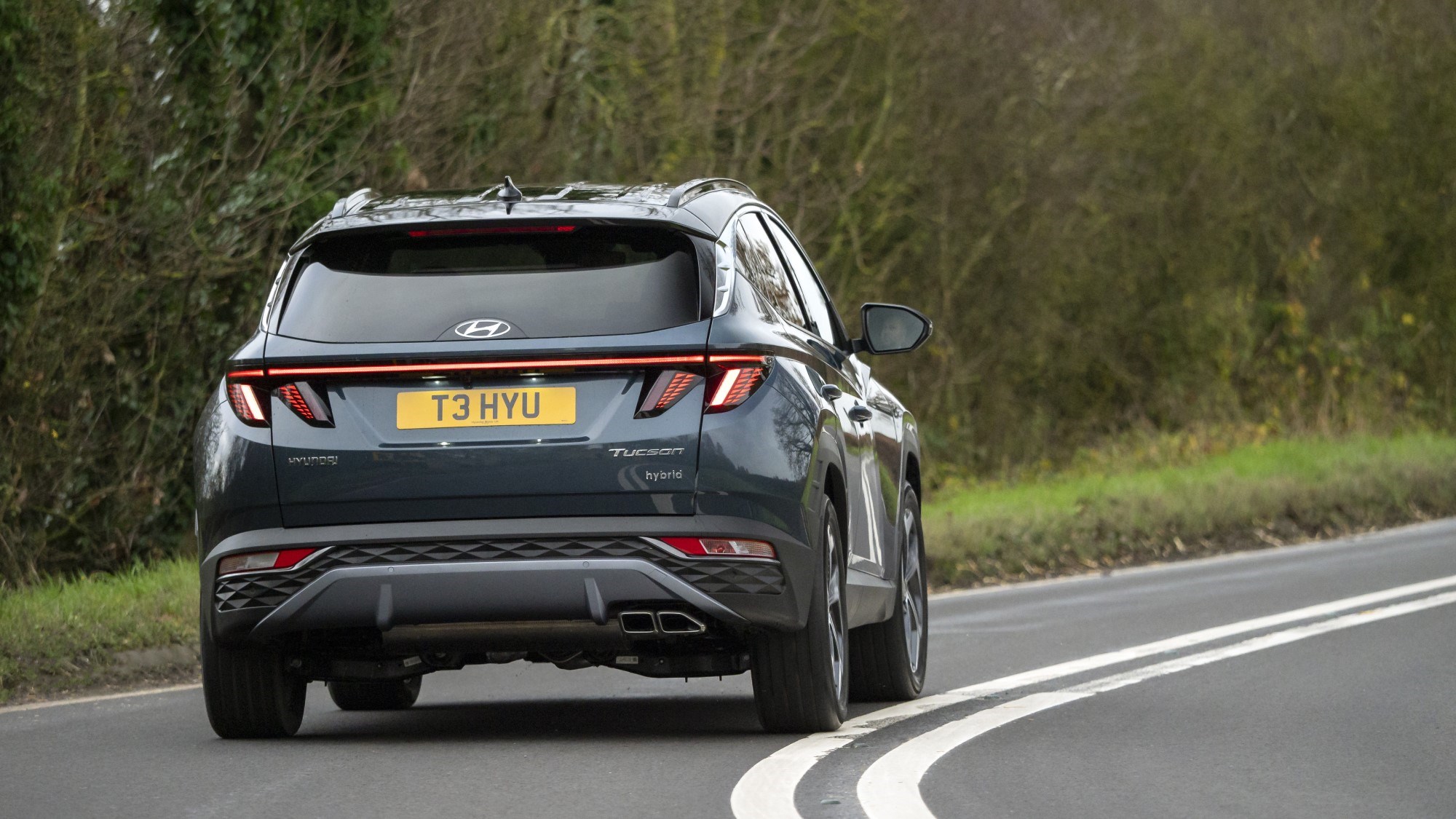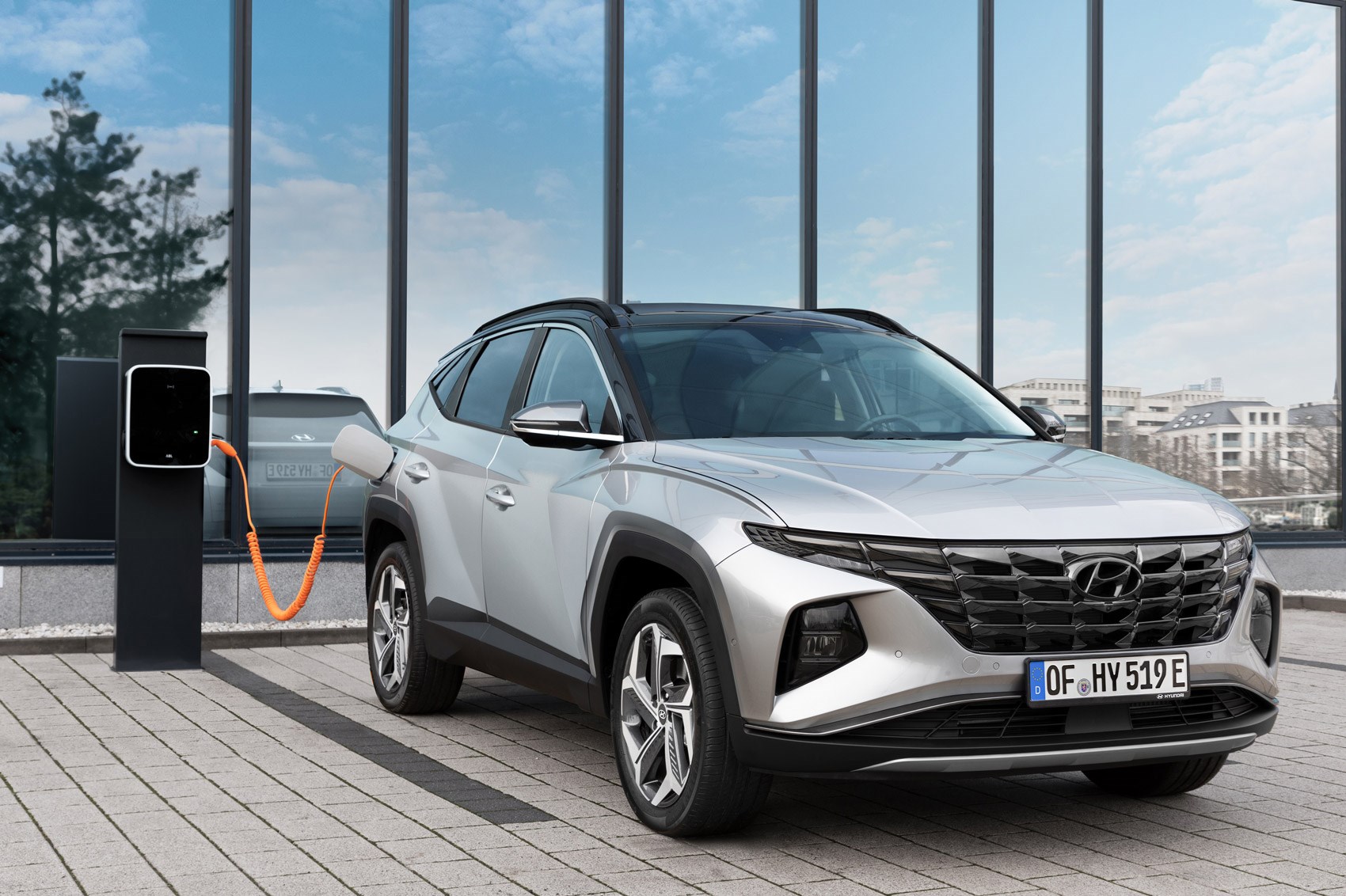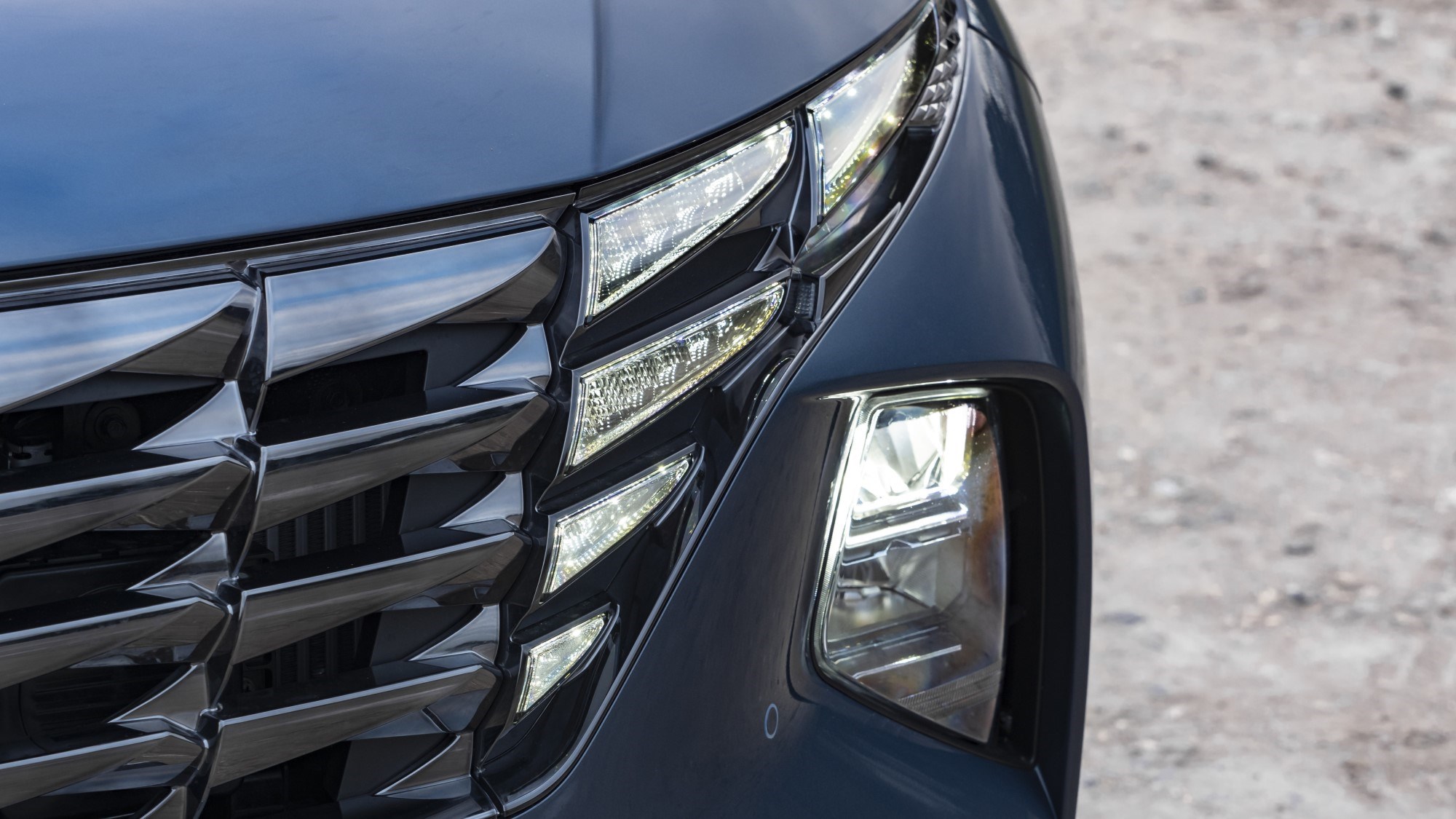► Fourth-generation Tucson driven
► Hybrid, PHEV and MHEV tested here
► Does sharp design make Hyundai’s SUV desirable?
The fourth-generation Hyundai Tucson SUV has enjoyed more than just a mild overhaul from its predecessor: the new car now comes with an electrified hybrid car line-up, plus the latest technology and a design that makes it stand out in the most crowded of markets.
CAR has driven a number of Tucson models now, including the self-charging hybrid, full hybrid and plug-in hybrid variants. Prices start just shy of £29,000, which means it needs to be very good indeed to justify itself against the competition.
Hybrid, you say? Have they got the date wrong for the combustion engine ban?
Don’t be fooled, the Tucson isn’t hybrid only. There are a variety of powertrains available from launch, all of which centre around a 1.6-litre turbocharged petrol engine. Base-spec models run this 148bhp unit without hybrid assistance of any kind at a cost of £28,760; a full £5000 more than the old Tucson on account of the great big dollop of standard equipment on the new model.

Don’t be fooled, the Tucson isn’t hybrid only. There are a variety of powertrains available from launch, all of which centre around a 1.6-litre turbocharged petrol engine. Base-spec models run this 148bhp unit without hybrid assistance of any kind at a cost of £28,760; a full £5000 more than the old Tucson on account of the great big dollop of standard equipment on the new model.
Add 48-volt mild-hybrid assistance into the mix with a starter/generator and you’ll add torque to the driveline as well as maximise engine start/stop to save fuel. Fuel economy is enhanced with an ‘intelligent’ six-speed manual that uses a clutch-by-wire system, automatically separating the engine from the transmission when slowing down, allowing the car to coast as freely as possible.
The next tier up is a more powerful, 177bhp mild-hybrid version of the 1.6 TGDi, which comes with a seven-speed dual-clutch gearbox (optional on 150PS mild-hybrid models) and on-demand all-wheel drive.
Move up a rung and the Tucson deploys a full hybrid, which gets a bigger 1.49kWh battery and a 44.2kW electric motor, which sits between the engine and the six-speed automated transmission to boost torque and reduce the need for combustion.
Finally, there’s the plug-in hybrid Tucson that benefits from a 13.8kWh battery pack and 66.9kW electric motor that’s good for 31 miles of electric-only range. Four-wheel drive is standard, helping to channel the 261bhp combined power output to the road. Prices for this start from £39,330, which is quite steep whichever way you look at it.
What’s the full hybrid like to drive?
The Tucson hybrid’s total system power is 227bhp, with 195lb ft of torque from usefully low revs. It’s a mellow companion around town, where the incessant orchestration of electric drive and gasoline combustion is harmonious and fluid, like Toyota’s highly evolved hybrids. You’ll see plenty of the EV-only mode light from the commanding driving position, popping up even at motorway speeds during light throttle loads. Steering is light but accurate, the rolling refinement good on 19-inch wheels beneath a body that bobs and rolls to keep occupants comfy.

The default driving mode is Eco, which includes a cease-and-desist order against heavy throttle: cross the line and you’ll get a groan of revs for minimal return. On twistier roads, select the alternative Sport mode (using an awkwardly positioned switch ahead of the cupholder), which frees up the accelerator for more linear, effusive power delivery, and some Mega Mass to weight up the rack.
The front end has plenty of grip, with two-wheel-drive versions feeling properly nimble – enough to question the need for all-wheel drive on more expensive versions; that only makes sense for the snow-bound or the outward bound, further supported by mud, sand and snow drivetrain settings. At the time of writing, Hyundai’s only offering this full hybrid model with front-wheel drive. Our tests of the full HEV gleaned fuel economy results between 39mpg and 48mpg.
How does the plug-in do?
Despite having more power overall, the four-wheel drive plug-in’s 8.6sec 0-62mph time isn’t quite as quick as the 8.0sec of the two-wheel drive only hybrid. Thank the extra bulk of the battery pack and extra drivetrain componentry for that. That does hurt agility a little, but then this isn’t the kind of car you’ll be hustling with regularity, is it?

Performance is perfectly adequate with both power sources chiming in, although in electric-only mode (the default when you fire it up) it takes a fair bit of time to haul itself up to motorway speeds. It’ll keep pace with rush hour traffic, but you’ll need to wake the engine if you’re in a hurry.
With the exception of the blunted performance, there isn’t a great deal of difference between this and the regular hybrid on the road. Yes, you’ve got far more electric range if you plug it in – albeit nearer 20 miles than the WLTP rating of 31 – but the engine sounds much the same while the handover between power sources is just as impressive. We only managed around 50mpg on a very short test route, but we didn’t take full advantage of the battery’s charge.
What about the mild hybrid?
As with most cars cut from this cloth, the hybrid assistance is unobtrusive – but it fills in the gap in torque at low rpm, giving this Tucson a diesel-like surge from as low as 1500rpm. Paired up to a quick-shifting if not overly smooth DCT it gets about with its business just fine.

Don’t go expecting much poise when rushing, though. Despite its 4WD there’s a tendency for it to scrabble its front wheels out of junctions, and the 1.6 takes on an unpleasant drone if you ask it to rev.
You can flay the hybrid from dormant to 62mph in eight seconds flat, but that rather misses the point. Hybrids are about conserving – not burning – fuel, with a real benefit in urban driving. Mixed-road testing gleaned anything from 35mpg to 48mpg – bound to be a shock to owners upgrading from a diesel Tucson, which would reliably hit 50mpg.
How does the Tucson ride?
When we first tested the Tucson, our highly-specced test car was in Ultimate trim with the optional tech pack, which includes Electronic Control Suspension (ECS). This adds adaptive damping to the front strut/rear multi-link suspension. The stiffer Sport setting irons out the relaxed gait in favour of a pretty uncompromising set-up – you’ll soon be switching back to Eco. Motorway refinement is fairly typical for an SUV: there’s a bit of wind noise, and a grumble from the borderline low-profile Michelin Primacy 4s.
Not wishing to sound like Goldilocks, but this ECS Tucson is either too loose or too firm for our tastes and best avoided – not least because the vast majority of UK cars will have passive suspension and front-wheel drive. On the passive suspension, there’s definitely a hard edge to the ride quality at lower speeds, even on the base-spec SE Connect’s balloon-tyred wheels. But that peters out when motorway cruising.
Big brother is driving you…
Truth be told, we were expecting a two-tonne kerbweight given the amount of Tucson tech (hybrid models actually weigh between 1564 to 1685kg depending on spec, PHEVs start at 1818kg). Driving forwards or backwards, braking, the view down the side, the front and back seats: everything is monitored and automated where possible. Even on the most basic of Tucson models, SE Connect, you will have rear parking sensors and camera, automated motorway driving, lane-keep assistance (one of the naggiest and most hyperactive versions we’ve tried) and emergency brake assist.

Go for the flashiest Ultimate versions, and you can have the ability to remote park the full hybrid using the key fob, surround parking cameras and Blind Spot View Monitor via an optional Tech Pack. You might have read about this on other Hyundai and Kia models: click the indicator and the rearward side view is usefully relayed in the digital binnacle, on the appropriate right or left side of the display. Unlike Audi’s similar system, the side mirrors remain.
Hyundai’s Blind Spot View Monitor: does it work?
Novel stuff includes a central airbag to prevent driver and passenger knocking heads together in an accident (thankfully untested), an alarm clock to wake traffic light dozers who fail to spot the car in front has gone, and a warning about opening the doors into oncoming traffic. Preposterously, there’s even an alarm to warn if you’ve left the kids in the back seats. All this feels like Hyundai is veering dangerously into tech overkill.
What’s it like inside?
The five-seat Tucson is longer, wider and fractionally higher than before, with a longer wheelbase. The upshot is generous interior space offering lots of legroom and space for big boots under the seats in front, though short kids might struggle to see out due to that kicked-up window line.
There’s a lot of attention lavished on the rear seats, and some of it’s welcome: the backrests recline (and naturally fold flat), and there’s a little switch on electric-powered front passenger seats, which makes it easy for the driver to slide it forward to give passengers easy access. Getaway drivers and chauffeurs will be delighted. Drivers can also instantly silence the rear speakers if the little ones have hung out the ‘do not disturb’ sign.

The hybrid’s wide, deep boot stows 616 litres (1795 seats folded). That’s fractionally down on the petrol car’s capacity, though with the 48-volt hybrid taking a bigger hit at 577/1756 litres and the PHEV down to 558 litres.
That’s plenty about practicality for everyone else. What about the driver? Unfortunately the driving position isn’t great. The base-spec SE Connect’s seats are flat and thinly-padded and no models have a great deal of adjustment for taller drivers. It almost feels like the pedals need to go further into the footwell for a more comfortable space, and it would be handy if the seat could be set lower, too.
What about that design?
We’ll get onto the exterior design, but let’s talk about the interior first. Upon first glance, this is a massive improvement on the drab cockpit of the previous-generation Tucson, with sweeping trim lines incorporated into the doors, a glossy dashboard panel and high centre console.
But in its efforts to dramatically update the crossover’s cockpit, Hyundai has also swept the buttons you might find useful – to control air-con and infotainment functions – into a panel beneath the touchscreen, and added a dash of miniaturisation too. The result is a row of tiny hieroglyphics without any tactile features to operate them, making them hard to use on the move.

As for the exterior, the front end looks sensational, with the fragmented grille resembling the feathers in an eagle’s unfurled wings, with the outer segments shape-shifting into daytime running lights when the car is switched on. The rear is equally eye-catching, with the shark-fin motifs peppering the rear lights and D-pillar brightwork delivering real stand-out, and a hidden wiper under the chunky spoiler. Shame the side section is so unfathomably overstyled – here, Hyundai’s cranked out more lines than Bart Simpson.
Hyundai Tucson hybrid: verdict
Hyundai has sold more than seven million Tucsons over the past 16 years, and it feels like it’s thrown everything at its new, global best-seller. But it doesn’t all quite gel. It’s hard to get comfortable in, some of the impactful interior design is a trade-off for usability and it’s creeping into £30k territory for a half-decent spec.
But this generation Tucson has impact like never before. It covers off the emotional with its design, the rational with its practicality, the advanced with its technology, and the zeitgeist with its focus on electrification. Hyundai, we salute your ambition.
View Hyundai Tucson hybrid lease deals
Specs below for a Tucson Hybrid SE Connect